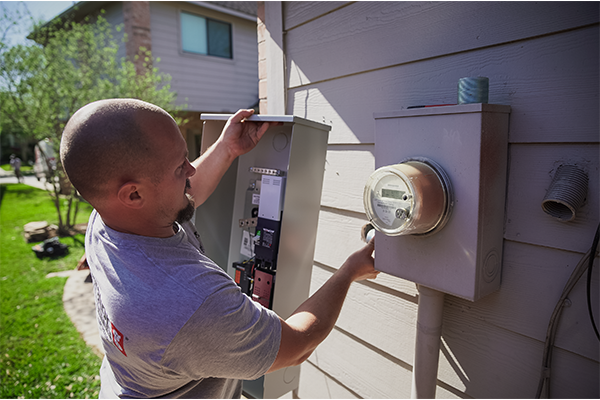Grid electricity works most of the time. But, according to Statista, the US only has a reliability index of 98.6 out of 100, behind countries such as South Korea, Finland, Hong Kong, and Belgium, making whole-home generators necessary.
But what are they and how do they work?
What Is A Whole-Home Generator?
A whole-home generator is a device that uses the principles of electromagnetic induction to generate electricity locally. It uses a portable fuel source (usually diesel) to rotate a coil between the poles of a magnet, generating an electrical current.
Whole-home electric generators typically have a wide range of power output capacities and can easily provide enough energy to keep even the most demanding household appliances running. While diesel whole-home generators were the most common in the past, manufacturers now make options compatible with petrol, LPG, and natural gas for lower emissions and less pollution. You can also connect them to renewable energy sources, such as solar-powered turbines, wind turbines, and batteries.
All whole-home generators offer some level of portability, with some vendors supplying products with wheels and handles, allowing you to move them between locations. Traditionally, generators were noisy like truck engines. But technology is improving all the time and now homeowners can keep generators close by, without noise pollution becoming a major problem. Engineers are also improving vibrating damping on their units, preventing annoying rumbling while in operation.
How Does A Whole Home Generator Work?
Practically all commercially available electricity generators for homes work on the principle of electromagnetic induction. While construction methods vary to some degree, the basic physics remains the same.
Inside any whole-home generator, there is a conductor coil, comprising a copper coil wound around a metal core. Taken together, engineers call this structure the armature. This component sits on an axle then runs between the poles of a horseshoe magnet.
Without any external supply of energy, the setup will not produce a current. However, when you rotate the armature using a motor, something magical happens – electricity will try to complete a circuit. The magnetic field lines between the two magnetic poles interfere with electrons in the conductor, inducing a flow of electricity, supplying enough energy for all your home devices.
The Components Of A Home Generator
Let’s dig a little deeper into the components of a home generator and how they all fit together.
The Engine
All electrical generators require some sort of mechanical input to rotate the armature. You can achieve this directly using natural means, such as a windmill, but most whole-home generators prefer a graduated and reliable engine as a power source.
The size of the engine determines the energy output of the generator. The more mechanical energy it yields, the more electricity the entire generator assembly can produce. In general, home generators use smaller motors than industrial models.
Engines come in two types:
- Overhead valve
- Non-overhead valve
In overhead valve engines, the engine’s intake and exhaust valves sit at the head of the engine’s cylinders. In non-overhead valve types, these mount onto the engine block.
When it comes to choosing a whole home generator, this distinction matters. Overhead valve designs offer multiple advantages compared to non-overhead standards, including lower noise levels, fewer emissions, and a more compact design. However, the price is generally higher.
Cylinder linings in generator engines matter a great deal. Ideally, you want a cast iron sleeve lining as this reduces wear and tear and increases durability. But you will need to check this specification with the manufacturer. Not all generators have it.
Alternator
A generator’s alternator has a similar purpose to the one on your car. It takes mechanical energy from the engine and converts it into electrical energy you can use in your home. It comprises the armature assembly we discussed above, creating electricity via electromagnetic induction (and related processes).
The alternator is a critical component of generators, so buyers need to pay careful attention to it.
Alternators, for instance, come in a variety of housing materials. Plastic housings are inexpensive, but they run the risk of becoming deformed over time. All-metal versions come in at a higher price point, but they usually last longer.
Alternators also come in brushed and brushless formats. Brushed versions use brushes to transfer electricity to a circuit, while brushless use sets of rotors that spin together, transferring energy between them. Because of the absence of friction, brushless motors tend to be more efficient and reliable.
Lastly, you’ll also want to consider the bearings the alternator uses. Needle bearings are cost-effective, but they do not last as long as traditional ball bearings.
Voltage Regulator
The voltage regulator is another critical component of whole home generators. Its purpose is to determine the potential difference of the system, ensuring that all your appliances and fittings receive optimal electricity levels.
So what does this particular component do?
Well, the concept can be a little tricky to understand. But the critical thing to remember is that voltage regulation is a cyclical process that involves switching between electrical states to achieve equilibrium.
The voltage regulator’s first task is to convert AC voltage from the motor to DC. It then feeds this current into an exciter winding to produce AC. This out then passes through rotating rectifiers, converting it back to DC. This energy transfers to the armature to create a DC. The armature then converts this to AC voltage, completing the cycle.
As the generator spins up, its output increases, and DC generation goes down. This process allows the generator to produce the precise type and intensity of current your home demands at any given time, just like mains power.
Cooling
Modern-day generators contain many moving parts, including engines, which heat up rapidly during operation. Therefore, just like cars and motorcycles, generators need cooling systems.
Some large generators use hydrogen as a stator coolant because of its high energy-absorption efficiency. Loops connect it to a secondary cooling circuit containing distilled water which then transfers heat away from the unit via traditional radiators.
In most domestic settings, however, standard radiators with fan attachments serve as the primary cooling system. Usually, there is no need for liquids. These are considered air cooled units, and are are similar to a motorcycle engine.
If a generator does use a liquid cooling system, owners should regularly check the condition of the pump and fluid regularly. You should replace fluids after around 25 days of cumulative operation.
Given that home generators require air to transfer excess energy to the environment, both manufacturers and regulators insist that you leave a minimum of three feet of space on all sides.
Exhaust Systems
When the generator’s engine burns fuel, it creates exhaust gases, just like a regular car engine. The exhaust system transfers these gases to a safe place in the external environment, before releasing them. Allowing gases to enter any of your rooms could be potentially fatal since they contain carbon monoxide.
Generators typically exhaust gases via metal pipes through an external flue. Pipes should be freestanding and not supported by the generator itself. They should also be connected to the engine with flexible pipes that absorb vibrations.
Where you can place exhausts depends on local regulations, so check your plans with officials before you begin construction.
Control Panel
Modern generators all have control panels – interactive displays that provide readouts and controls for your unit. They offer functions such as start-up and shut down, meters showing you current, voltage, and operating frequency, and other controls for switching between manual and automatic power transfer.
How Automatic Transfer Switches Work
An automatic transfer switch is a clever device that turns on your generator the moment the grid electricity supply to your home fails.
Here’s what happens in a simple, step-by-step process:
- The transfer switch monitors the main utility to your home 24 hours per day.
- If it detects an interruption in the mains line, it sends a signal to the generator to start up.
- Once the engine and armature are up to the appropriate speed, the transfer switch shuts off the utility line and opens the power line from the generator
- The home now begins receiving generator-produced electricity
- While the generator is running, the transfer switch continues to monitor the utility line. If it detects restoration of power, it will shut down the generator and revert to the mains power supply
- If the transfer switch detects a resumption of utility power and switches the line back over, it will continue to run the generator in “cool-down” mode to wind it down safely
Wrapping Up
Electric generators are useful for homes during power outages. They let you keep the lights on, even when the whole neighborhood is out. They are particularly beneficial in distant areas where restoring power supplies is difficult and in storm-affected regions.
Knowing how whole-home generators work makes it easier to make a smart purchase. This article taught you which features to look out for, and how spending a little more on your unit often grants access to higher-quality components.






